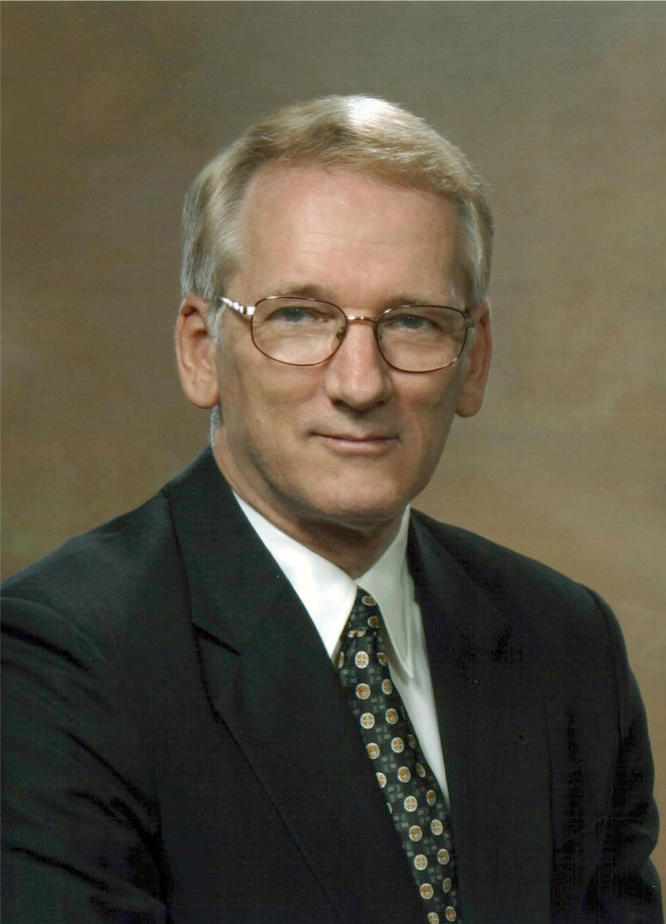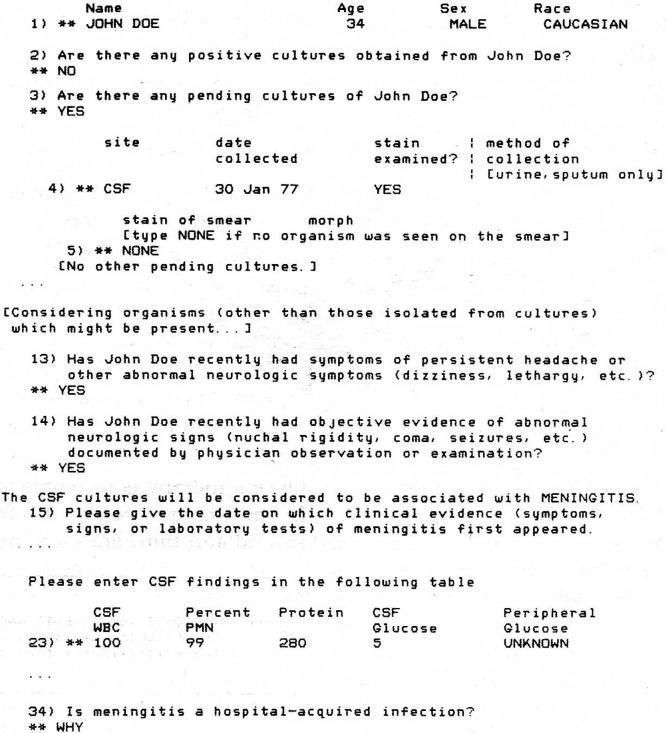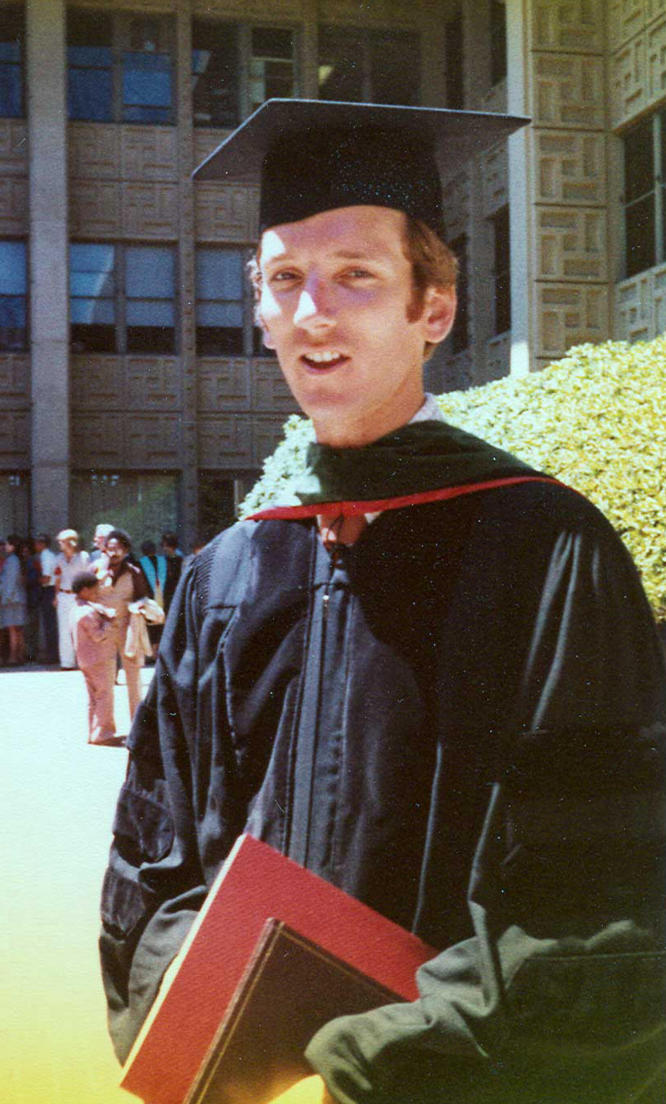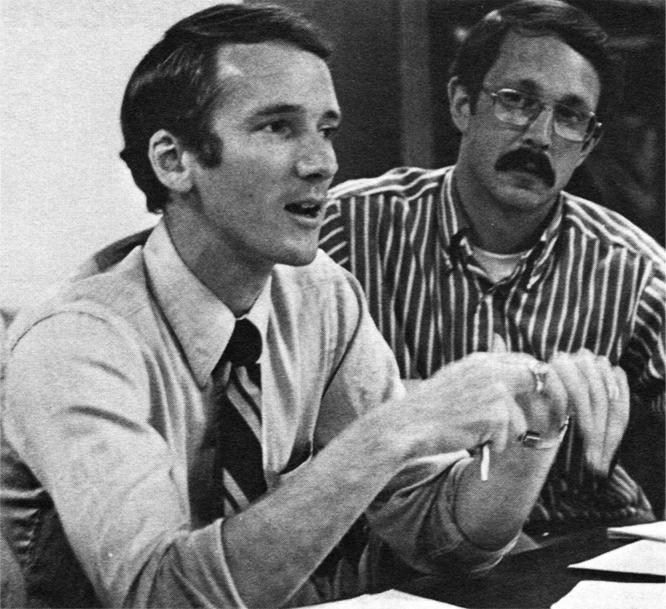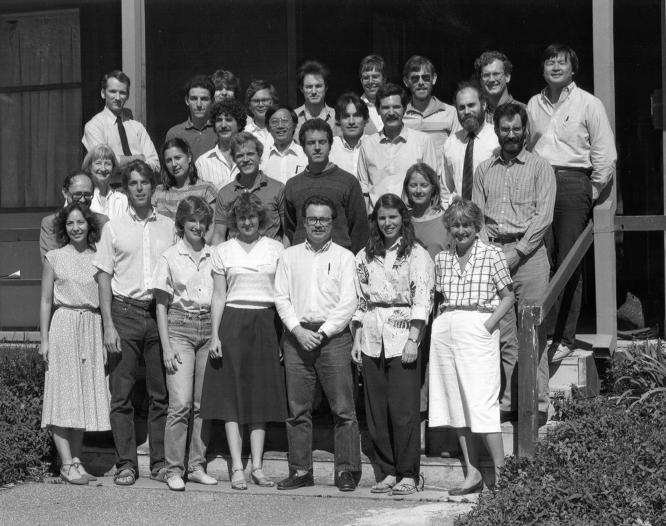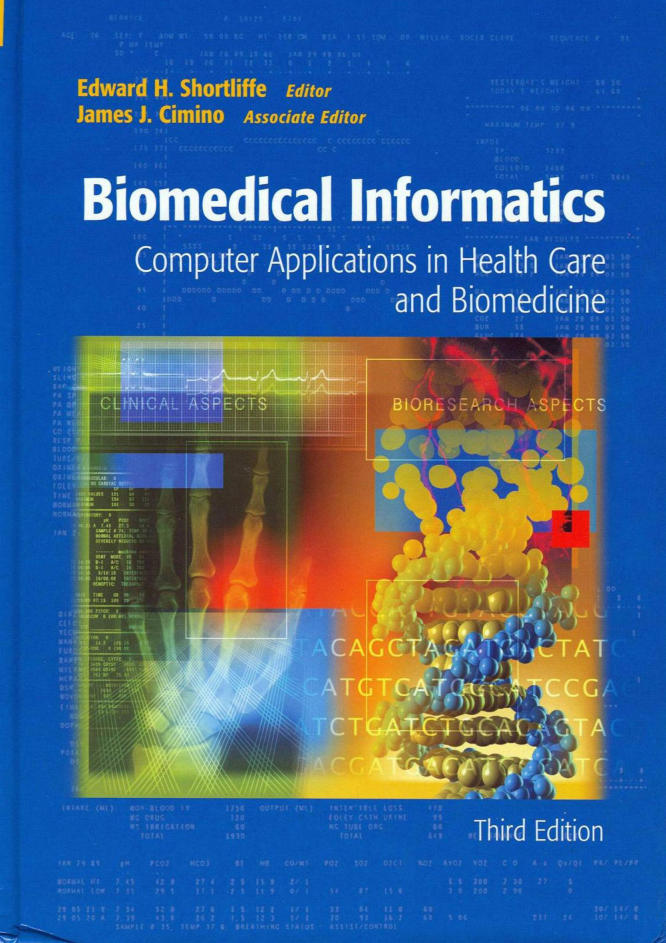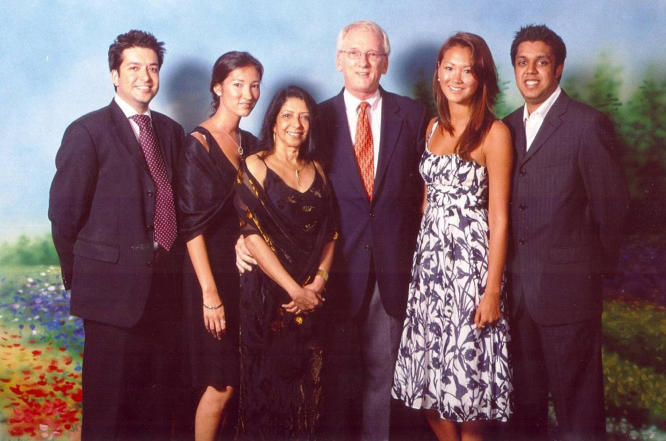The American College of Medical Informatics is an honorary society established to recognize those who have made sustained contributions to the field. Its highest award, for lifetime achievement and contributions to the discipline now known more inclusively as biomedical informatics, is the Morris F. Collen Award. Dr. Collen’s own efforts as a pioneer in the field stand as the embodiment of creativity, intellectual rigor, perseverance, and personal integrity. At most once a year, the College gives its highest recognition to an individual whose attainments have, throughout a career, substantially advanced the science and art of biomedical informatics. In 2006, the College was proud to present the Collen Award to Edward Hance Shortliffe, M.D., Ph.D. (▶). As a physician, computer scientist, researcher, educator, and eloquent spokesperson for the field, Dr. Shortliffe’s career contributions make him most deserving of the recognition embodied in the Collen Award.
Figure 1.
Edward H. Shortliffe, M.D., Ph.D.
Beginnings
Edward “Ted” Shortliffe was born on August 28th, 1947, in Edmonton, Alberta, Canada (see ▶). Ted’s father was a physician and hospital administrator and his mother was a high school English teacher. The family moved to Connecticut while Ted was a youngster (1954), and in 1962 he became a U.S. citizen.
Figure 2.
Ted Shortliffe, circa 1948.
After graduating from high school and spending a year as an exchange student in Great Britain, Ted entered Harvard in the fall of 1966. As an undergraduate, he sought a research project in applied mathematics, which was the concentration at Harvard at the time that included computer science. An advisor steered Ted to the Laboratory of Computer Science (LCS) at Massachusetts General Hospital (MGH). The LCS, directed by Octo Barnett, would become Ted’s first contact with the burgeoning field that would later become biomedical informatics. On that first visit, Ted was introduced to Bob Greenes, who was working toward a post-M.D. Ph.D. degree in computer science (Applied Mathematics) at Harvard.
“I was fortunate to attract Ted to a project I was working on for my Ph.D. thesis, a structured reporting system that I was building and evaluating, designed for capture of clinical progress notes from physicians. Ted’s first project in biomedical informatics was an extension of that system aimed at implementing a structured input interface for composing research retrieval queries that could be run against the database of patients collected in the clinical system. This work became the subject of his honors thesis for his Harvard degree. I could tell at that very early stage that Ted had extraordinary promise as a cogent, creative thinker, with a high degree of technical skill, and with boundless energy and enthusiasm.”
— Bob Greenes
“My introduction to the LCS was a huge discovery for me; I hadn’t known that such places or activities existed…I went over there and got a job actually working with Octo and Bob Greenes, who was doing his Ph.D. at the time. And I just knew from the very beginning that I didn’t need to choose anymore between medicine and computer science—I could do both.”
— Ted Shortliffe
“Most … are not aware of his early training in this black art. It was almost 40 years ago that this young Harvard undergraduate found his way into my laboratory—located in an old nursing dormitory among the rat animal cages. He seemed a likable and promising lad, and became an important member of a wonderful group of youngsters who joined the lab in those early years. They shared the advantage of learning to program on a PDP-9, which may explain why they all left the lab for greener pastures. … I thank my friend, Ted, for the opportunity of working together over these years. He has certainly done very well considering the limitations of his early training.“
— Octo Barnett, Massachusetts General Hospital, Professor, Harvard University
In 1970, Ted graduated from Harvard magna cum laude with an A.B. in applied mathematics and computer science.
“While we wanted to keep Ted at Harvard, he was attracted to Stanford and its M.D.-Ph.D. Medical Scientist Training Program.”
— Bob Greenes
The Stanford Years
Ted was fortunate to arrive at Stanford at a time when Joshua Lederberg, Edward Feigenbaum, Bruce Buchanan, and others were exploring the development of artificial intelligence approaches to medicine and molecular biology. He came to Stanford as an M.D.-Ph.D. student, one of a very select group of young scientists admitted into that program. His research advisor was Stan Cohen, probably because Stan was one of the few clinical faculty in the Medical School working with computers. Although Stan went on to invent gene splicing, his work at the time involved developing a computer program that could reference a large data base of drugs and identify the possibly deleterious effects of administering combinations of them. 1 Gio Wiederhold was working with Stan on database development and Bruce Buchanan was involved on the artificial intelligence side.
Ted’s undergraduate experience working with MUMPS in the MGH LCS instilled in him good program design principles and considerable programming skills. At Stanford, he enrolled in a computer science course, Introduction to Artificial Intelligence (AI), taught at the time by Cordell Green and Jerome Feldman. Ted started spending time in the Dendral project lab (the Heuristic Programming Project), run by Feigenbaum, Lederberg, and Buchanan, to find out more about AI.
At the lab, Ted noticed there was no regular journal club, so he organized one, with a focus on journal articles about innovative uses of computers in medicine. Patterned after the ACM’s special interest groups–the SIGs–the lunch-time journal club was called “SIGDoc.” Years later the scope widened beyond medicine (so the name changed to “SIGLunch”) and it became the longest running informal colloquium devoted to AI topics—an early indication of Ted’s perceiving a need and finding a way to fill it.
MYCIN
The first research project Ted and Stan Cohen sketched out was to develop a computer program that could help clinical practice review boards decide when a clinician had made gross errors in prescribing drugs. Quickly, however, they saw the wisdom of offering advice to clinicians before they made errors. A program that only criticized physicians after the fact was sure to be itself the subject of much criticism. But in order for a program to know that a drug was inappropriate, it first had to decide which one(s) would be appropriate. This was the origin of his Ph.D. research problem, for which Bruce Buchanan became Ted’s unofficial advisor.
Cordell Green suggested that Ted do his programming in Lisp, and got him set up with an account at Stanford Research Institute (SRI) to work over the ARPANet, the forerunner of the Internet, so he could work with the new, interactive version of Lisp (which became InterLisp) developed at Bolt, Beranek, and Newman, Inc. Cordell’s class had also introduced Ted to Carbonell’s program SCHOLAR, which answered questions about the geography of South America based on facts stored in a large semantic network. So the first prototype of the program that was to become MYCIN was designed as a semantic net, question-answering machine. He ran experiments on that early program and concluded that spreading activation through a semantic net was not a precise enough reasoning mechanism for clinical decision making. Thus, the design of MYCIN was revised to build on the production rule approach used by Dendral.
Production rules were known to be useful in compiler design, and were being used at Carnegie Tech (now Carnegie Mellon University) to build psychological simulations of human reasoning. The Stanford group believed that systems of production rules could encode the knowledge of experts and drive a simple reasoning system for reasoning about complex problems. A part of the Dendral project had demonstrated its feasibility. Ted was eager to try using production rules to encode Cohen’s knowledge about drug use in clinical medicine, using a cleaner design than Dendral’s. Ted and Stan wisely decided that antimicrobial therapy for bacteremia was sufficiently complex.
“It was clear from the beginning that Ted had a remarkable insight into both what was needed in biomedical computing and for what was needed in clinical medicine. MYCIN at that time was an especially remarkable accomplishment for a young graduate student, also a medical student, spending his time in medical studies and also spending much of his time writing the algorithms and having the discussions necessary in order to bring MYCIN to fruition.”
— Stanley Cohen, Professor, Stanford University School of Medicine
“Ted was the brilliant kid from their yard, the Stanford medical school, who came to play in our yard. He demonstrated to us with his Ph.D. thesis on MYCIN how to do expert systems another way. So thanks Ted for everything you were able to do for us at Stanford over all of those years…it was really wonderful.”
— Edward Feigenbaum, Chair, Computer Science at Stanford, 1970s
“My years at Stanford were kind of magical…I was in a wonderful supportive environment. My Ph.D. advisor was Stan Cohen, who’s best known for gene splicing and his work as a geneticist…and I think he instilled in me a real belief that biomedical informatics and what I wanted to do was as rigorous scientifically and as important as anything I might do with test tubes in a laboratory. I’ve tried to maintain that philosophy not only in my own work but in the way I’ve trained students ever since.”
— Ted Shortliffe
At the start, Ted and colleagues at Stanford believed that all the relevant medical knowledge about bacteremia and antibiotics could be encoded in production rules. Friends at MIT took exception to this, arguing in many spirited discussions that frame-based representations were necessary (and sufficient). The truth turned out to be that both approaches could work, and MYCIN encoded a substantial amount of its knowledge about clinical medicine in class-instance hierarchies and property lists. Overall, however, the reasoning in MYCIN was simple backward chaining through the production rules, starting with the goal rule, which was (more or less): “If the patient’s infection is significant and the cause of the infection is known, then prescribe the drugs effective against the cause of the infection.” 2
One problem that consumed more time than any other in the design of MYCIN was how to determine the strength of belief when the evidence for a belief is not known with certainty and the inference rules themselves are less than certain. Bayes’ Theorem was known to the group, as was the work by Gorry and Barnett 3 that showed how Bayes’ Theorem could be used sequentially through a chain of inferences. But Bayesian reasoning required numbers for both prior and conditional probabilities that the project’s clinicians could not provide. There were too many widely variable estimates for the probabilities, and the clinicians didn’t know all of them in any case. What they could give, however, was a single number for each rule: If you knew the facts mentioned in the antecedent with certainty, how much more would you believe the fact(s) mentioned in the conclusion (on a 1–10 scale).
MYCIN’s introduction of certainty factors (CFs) and a CF-combining calculus initiated a new set of concerns about reasoning under uncertainty, 4 which has become a substantial focus of AI research. Although Heckerman and Horwitz later showed 5 that there was a probabilistic interpretation of this number—as a probability update—the strength of belief (called a CF) was conceived as a degree of confirmation and not a probability. ∗
Ted had a self-imposed deadline of two years for his Ph.D. research and dissertation. 6 Because MYCIN required solving new problems in clinical decision making, such as managing uncertainty, he finished in two years and a summer—just before classes began in the fall. He could not take the summer off, as he had planned.
Although it was never deployed outside of the experimental setting, MYCIN was shown in a 1979 evaluation to equal or to outperform members of the Stanford infectious disease faculty on sample cases (see ▶). The MYCIN work has been one of the most heavily cited advances in our field.
Figure 3.
Sample MYCIN consultation session.
One year following his 1975 Ph.D. degree, in 1976, Ted obtained his M.D (see ▶), and received the Grace Murray Hopper award of the Association of Computing Machinery (ACM). The ACM gives the Hoppper award to a distinguished scientist under age 30 for important contributions to the field.
Figure 4.
Edward H. Shortliffe, MD, PhD, at Stanford graduation, 1976.
Ted’s work on MYCIN clearly demonstrated the potential of using production systems for encoding knowledge of experts and bringing it to bear on new problems. Randall Davis and William van Melle, two computer science students at Stanford, drove home the point that MYCIN-style systems could be used in domains outside of medicine. Van Melle’s dissertation research removed all remaining references to medicine in the code, leaving a “shell” system called EMYCIN. This was the origin of the concept of expert system shells in which domain-specific knowledge is cleanly separated from domain-independent representation and reasoning mechanisms. Davis expanded the explanation system in MYCIN and showed the power of having the system explain its own reasoning—both for understanding the rationale behind a recommended action and for determining the sources of errors in the knowledge base.
In the decade after Ted finished his dissertation, at least five other Ph.D. dissertations at Stanford directly built upon his work, and numerous other projects were spawned from it. A number of Stanford colleagues, including Ted, started the first expert systems company. Rule-based expert systems based on MYCIN and EMYCIN are widely used today in a broad spectrum of domains and applications areas. †
Because of the wide interest that MYCIN had attracted, Ted suggested (while he returned to Boston and MGH to serve as a medical intern) writing a book based on the published papers of the students and visiting researchers who had worked on MYCIN. 6 What seemed like a simple task stretched on for several years. It included twenty-four published papers and twelve new chapters summarizing the experimental work and lessons learned from MYCIN.
In the Foreword to the MYCIN book, Allan Newell wrote that the emergence of expert systems transformed the field of AI and that MYCIN is “the granddaddy of them all—the one that launched the field.”
“They separated the program from the knowledge base, they separated the reasoning from the output, they required the program to be able to justify their conclusion. All of this was very transparent. And that approach that he brought as a medical guy to the computer science department really contributed tremendously to the whole founding of the field of medical informatics. … The first time I met him I was introduced to him by Ed Feigenbaum who said, ‘Don I want you to meet Ted Shortliffe; he’s really brilliant’. I thought of Ed Feigenbaum in those terms and he didn’t use that terminology very often for anybody else, but he was right in this case…and I’ve enjoyed knowing Ted every day since those early days.”
— Donald A.B. Lindberg, Director, National Library of Medicine
Ted’s career at Stanford was interrupted only by his one-year internship back at MGH before returning for a residency in Internal Medicine at Stanford. There, he joined the faculty in the Departments of Medicine and Computer Science in 1979. He worked closely with Bruce Buchanan (see ▶) and other members of the Stanford Computer Science Department, and initiated the NLM-sponsored Stanford Training Program in Medical Informatics. In 1982, Ted established the Section on Medical Informatics (SMI) in the Stanford University School of Medicine’s Department of Medicine, and would continue to call Stanford home for the next two decades. Under Ted’s leadership the SMI grew to become one of the premier medical informatics laboratories in the world (See ▶).
Figure 5.
Ted Shortliffe and Bruce Buchanan as young Stanford faculty members, circa 1979.
ONCOCIN
At Stanford in the 1980s, the MYCIN program led to the ONCOCIN Project, which was supported in part by major grants from the National Library of Medicine. The ONCOCIN project—deliberately designed to be challenging as well as clinically useful—was Ted’s first major project after joining the Stanford faculty and was an active effort from 1979 to 1987. 8, 9
“The domain we chose was the field of clinical oncology, in particular the management of patients enrolled in chemotherapy protocols.”
—Ted Shortliffe
“One of the key moments in the development of expert systems here at Stanford … was a presentation, in 1986, by Ted to the Xerox Palo Alto Research Center. It was one of the first demonstrations of medical expert systems using graphical user interfaces, and even though the people at Xerox had developed the graphical user interface, they had never seen the kind of interfaces that we were showing. It was really a key milestone in the development of the ONCOCIN system, which followed on Ted’s early work in MYCIN.”
—Larry Fagan, Faculty Member, Stanford
The ONCOCIN problem was, indeed, challenging. The clinical goal was to tailor oncology therapy to individual patients within the guidelines of experimental oncology protocols, thus keeping them on protocol as long as possible. The AI and informatics goals came to be understood, inter alia, as representing the time-course, including loops, of clinically significant events in the protocols, and representing the variability and uncertainty implicit in the protocols. The oncology protocols themselves were complex and were essentially paper documents. The discipline of representing them for ONCOCIN occasionally revealed inconsistencies and holes. ONCOCIN, like MYCIN, spawned several other Ph.D. dissertations.
SUMEX-AIM
The SUMEX-AIM computer resource was established in 1973, when Ted was still a student. Funded by the Division of Research Resources of the NIH (which later became the National Center for Research Resources), SUMEX-AIM provided computational resources to investigators at Stanford. From the outset, the resource also extended these capabilities to the external investigator community via early Internet access. Nobel Laureate Joshua Lederberg was the first SUMEX-AIM principal investigator (PI), and when he left for Rockefeller University, Ed Feigenbaum took over as PI. 10 When Ted joined the faculty, Ed made Ted the PI, and this arrangement continued through the last nine years of the project (out of 18). Ted then initiated, as PI, the NLM-funded CAMIS grant, which was the successor to SUMEX and continued for another five years.
Ted’s initial research on MYCIN (and the continued work on DENDRAL) were part of the justification for the initial SUMEX proposal. The SUMEX computer was a DEC-10 (later a DEC-20) running LISP, which became the “home machine” for Ted’s work for the next 18 years as well as the shared resource of several other biomedical computing groups around the country. In the 1980s it was the pioneering SUMEX systems staff, under Tom Rindfleisch’s direction, that helped SMI to bring in individual LISP machines and graphical workstations. It’s important to note that SUMEX was the first non-DOD machine to be connected to the ARPAnet.
“Part of his skill is being articulate, but also it involves building an environment where smart people want to come, where new ideas happen and are valued and pursued. Ted has been extremely effective and generous of his time in helping to enunciate and shape informatics policy at local, national, and international levels.”
— Tom Rindfleisch, Senior Associate Dean for Research emeritus, Stanford University
“Speaking personally, my collaboration with Ted was always intense and interesting. Our few disagreements engendered lively discussion and not once left either of us feeling anything less than renewed respect. There were many priceless years of collaborative work on MYCIN while he was a student and then again after Ted returned to Stanford as a faculty member. In his student years we were merely predicting that he would be a star; but as we saw his leadership and organizational skills at work nationally and internationally, we could see our predictions come true. I continue to value his opinions on every matter, and value his friendship even more.”
— Bruce Buchanan
Education and Training
A major thrust of the Stanford program in medical informatics was its focus on graduate and postdoctoral training. As the program director of one of the earliest of the National Library of Medicine’s institutional training grants in medical informatics, Ted established a program that has over the years been a model for many other programs, in terms of its formal grounding in the disciplines underlying informatics, and the emphasis on a scientific approach to system development and evaluation. 11 A testimony to the success of the program is the cadre of graduates who have gone on to illustrious careers at Stanford and elsewhere, both in academia and industry. With those that stayed on as faculty, and under Ted’s leadership, the Stanford program quickly developed a reputation for the high quality of its students, excellence of its training, and innovation in its research. Many alumni have warm memories of their years in training, the esprit de corps, and the excitement and vibrancy of the program (See ▶, first trainees of SMI).
Figure 6.
Ted Shortliffe, Section of Medical Informatics faculty, staff, and students, 1985. First row: Leslie Perreault, Glenn Rennels, Joan Differding, Janice Rohn, Mark Frisse, Holly Jimison, Darlene Vian (administrator). Second row: Gio Weiderhold, Allison Grant (secretary), Isabelle deZegher-Geets, Steve Downs, Curt Langlotz, Janet McLaughlin, Michael Kahn. Third row: Ted Shortliffe, Thierry Barsalou, David Heckerman (back), Hank Rappaport, Greg Cooper, Samson Tu, Eric Horvitz, Christopher Lane, Cliff Wulfman, Mark Musen, David Combs, Larry Fagan, Don Rucker, Homer Chin.
In addition to its formal degree-based training program, Stanford pioneered a weeklong intensive Introduction to Medical Informatics, as one of the first highly successful short courses in the field. During Ted’s tenure at Stanford, SMI also developed an Industrial Affiliates program, seeking to bring knowledge of the field and involvement with it to an ever greater number and variety of professionals.
Ted’s other responsibilities at Stanford included his clinical roles as a general internist in both inpatient and outpatient settings and, from 1988 to 1995, duties as Chief of the Division of General Internal Medicine in the Department of Medicine. In addition, after turning over the reins of the SMI to Mark Musen in 1995, Ted assumed responsibility as associate dean for information resources and technology at Stanford University School of Medicine. There, he oversaw the development of educational technologies and library information services under the leadership of his faculty colleagues. His university-wide roles included five years as a member of the Stanford Advisory Board, an elected group of seven professors from throughout the university who advised the provost on all tenured appointments and promotions as well as faculty disciplinary matters.
“Ted, what a time we’ve had since May, 1980…wonderful students, great parties, and oh those crummy budgets…all so memorable!”
— Darlene Vian, SMI Administrator, Stanford University
“For those of us who didn’t have clinical training or came to the program more from the engineering side, he allowed us to have exposure with clinical clerkships to a variety of hospital and out-patient settings. So we all developed a clear understanding for a need for a multi-disciplinary approach where you understood the aspects of the problem from all sides.”
— Holly Jimison, Associate Professor, Oregon Health Sciences University, former trainee
“Ted would take us on ski trips to Lake Tahoe and he’d encourage a lot of extracurricular activities for students and faculty to socialize. In all those occasions he would always have some comments on the newest technology or newest political development that would impact medical informatics, research, and training.”
— Lucila Ohno-Machado, Brigham and Women’s Hospital, Associate Professor, Harvard University, former trainee
“Ted has the singular ability to look at work in context and was extremely influential in the medical informatics community in adopting an experimentalist approach to the work that we do. I think he will always be known for that.”
— Mark Musen, Professor, Stanford University
“One of the great things about Ted is his commitment to training and mentoring the next generation of informatisists…I’ve been extremely fortunate to benefit from Ted’s advice and support for almost 20 years.”
— Ida Sim, University of California San Francisco, former trainee
“I think Ted Shortliffe made a conscious decision to broaden the scope of what was then viewed as medical informatics—largely focused on medical decision-making—deliberately to include the emerging molecular biology.”
— Donald A.B. Lindberg
“I’m personally grateful to Ted for his mentorship over the past 20 years…and Stanford of course is extremely grateful for his starting the Medical Information Sciences program in 1982. We’re now in our 26th or 27th year. We’ve been renamed biomedical informatics but we very much continue in the tradition that Ted started.”
— Russ Altman, Professor, Stanford University
When Columbia beckoned in 2000, Ted’s move to New York was of course Columbia’s gain, although he left behind at Stanford a strong program in the capable hands of several of his protégés and former trainees.
“We do miss Ted Shortliffe here as an integrating force and wish him much success at Columbia.”
— Gio Wiederhold, Professor emeritus, Stanford University
The Columbia Years
At Columbia Ted became Professor and Chair of the Department of Biomedical Informatics, subsequently becoming the first incumbent of the Rolf A. Scholdager endowed professorship. Ted consolidated an already strong program established by its founding Chair, Paul Clayton, into an even stronger one, doubling the size of the faculty to 35 individuals and expanding the training program to almost 60 students. He continued his philosophy of scientific and educational rigor in that program. Under his academic and administrative leadership, the Department of Medical Informatics was renamed the Department of Biomedical Informatics in 2003 to reflect the field’s expanding breadth of education, research, and practice. Ted oversaw the expansion of the graduate education and research training program in these diverse areas. He established a new graduate track in public health informatics as well as the introduction of biomedical informatics education for medical students. Ted also led the continued development of the department as a key participant in the development of systems for patient care. He stimulated, for example, an infection control initiative and promotion of a clinical data warehouse, and he recruited new faculty to conduct fundamental research in the underlying principles and methods of biomedical informatics. The department’s research funding substantially expanded, including growing prominence in bioinformatics that led to Columbia’s selection as one of the coveted Centers of Excellence in Biocomputation in 2005.
“Before Ted came, I was struck by two things about Stanford informatics students: they gave excellent presentations and they knew about my research. I knew that the first was due to the efforts of Ted and others to work with the students as they prepared for public speaking; I was inspired to try to help our students acquire similar skills. I didn’t find out the source of the second until Ted came to Columbia and instituted the oral exam, which included knowing who was doing what in the field. Ted brought that exam to Columbia, along with other elements of Stanford’s more mature educational program. The result has been a wonderful cross-fertilization of the two programs, allowing us to provide a much richer experience for the trainees, while making the faculty feel like they are part of a comprehensive educational process from which we all learn and benefit.”
— James Cimino, Professor, Columbia University Biomedical Informatics
“Ted shepherded the Department of Biomedical Informatics to become a mature research environment with a broad coverage of informatics. He made the graduate program simultaneously more rigorous and more humane for the students. He built industry ties and worked hard to advance the field of biomedical informatics.”
— George Hripcsak, Professor, Columbia University Biomedical Informatics
“Ted’s efforts at Columbia are most clearly seen in two areas: how he has enhanced the educational component of the department, and how he has coordinated a convergence of bioinformatics and clinical informatics expertise. I believe he has been able to do both of these successfully because he could characterize and elucidate the core principles, or methods of biomedical informatics. By focusing on the similarities in theory, rather than the differences in application, he was able to create a cohesive framework that not only facilitated teaching and research between the two fields, but allowed the inclusion of many other applications that shared the same theoretical informatics methods.”
— Adam Wilcox, Assistant Professor, Columbia University Biomedical Informatics
“One of Ted’s most important contributions at Columbia was increasing the visibility of biomedical informatics across the four health sciences schools. Through joint appointments of faculty in Dentistry, Nursing, and Public Health, the gospel according to Ted was broadly disseminated.”
— Suzanne Bakken, Professor, Columbia University Biomedical Informatics
“Dr. Shortliffe’s vision of a common methodological basis for Clinical Informatics and Bioinformatics has had a major role in shaping the synergy between these two disciplines both within the department and, more broadly, in the context of many translational research activities at Columbia. Identifying these commonalities and implementing his vision has allowed for the creation of an extremely strong and vital research program coupled with one of the nation’s top educational programs in biomedical informatics. In combination, these address a full spectrum of research activities at the boundary between the computational, the biological, and the clinical sciences.”
— Andrea Califano, Professor, Columbia University Biomedical Informatics
“I vividly remember and am deeply grateful for the monthly meetings of junior faculty members with Ted. This mentor extraordinaire inspired and exercised us to conceptualize and execute projects beyond expectations.”
— Yves Lussier, Associate Professor, University of Chicago, former trainee and faculty member at Columbia
“While learning from Ted, I began to understand the significance of his contributions to biomedical informatics, medicine, and computer science. While teaching with him, I’ve witnessed his enthusiasm for helping students and his passion for education. While watching him lead the department at Columbia, I’m consistently amazed by his range of knowledge and his understanding of institutional dynamics. And while getting to know him, I’ve found that he’s a really nice person. It’s been a real privilege to study and work with Ted.”
— Michael Chiang, Assistant Professor, Columbia University Ophthalmology and Biomedical Informatics
Ted held a number of other important leadership posts at Columbia University Medical Center, including deputy vice president and senior associate dean for strategic information resources, as well as professor of medicine and professor of computer science. He also served as director of the Center for Advanced Information Management (a New York State funded entity that promotes technology transfer and economic development in the state), and director of medical informatics services for New York-Presbyterian Hospital.
In this country weather travels from the West to the East. Ted came to Columbia and New York-Presbyterian like a storm out of the West. Like a hurricane he shook things up. But unlike a force of nature, he put things back together better than he found them. Biomedical informatics is such an interesting field. It’s always looking forward. A great department of informatics is built around the question, “what next?” And a great chairman is always asking himself that question. Ted is good at asking what is next and its corollary, “how can we get this done?” In his time with us he was unyielding in his insistence that his discipline was both academic and operational in nature. He brought the rigor of an academic approach to the problems that must be solved every day in a hospital … And he is the nicest guy. Ted is a gentleman. My institution will miss his steady hand and good natured approach to collaboration. I will miss his sense of humor, his willingness to negotiate, and the flash of steel that showed when we reached the limit of negotiation. I will miss all of that. “The weather has shifted and for the first time the wind blows from East to West. It will be tremendous fun to see what Ted makes in Phoenix.”
— J. David Liss, Vice President, Government Relations & Strategic Initiatives, NewYork-Presbyterian Hospital at Columbia Presbyterian Medical Center
“At Columbia Ted has created a very fine environment of consideration, of intellectual honesty and cooperativeness that I think is unrivaled … and a real tribute to Ted personally and professionally.”
— Donald A.B. Lindberg
Beyond the Walls of Academia
Ted has served in many capacities in the national and international arenas of biomedical informatics, where he has become an influential spokesperson for the role of informatics in biomedical research and in the delivery of health care. He currently sits on the oversight committee for the Division of Engineering and Physical Sciences of the National Academy of Sciences and the Biomedical Informatics Expert Panel of the National Center for Research Resources. He has previously served on the National Committee for Vital and Health Statistics and on the President’s Information Technology Advisory Committee. Earlier he served on the Computer Science and Telecommunications Board of the National Research Council, and the Biomedical Library Review Committee of the National Library of Medicine.
Ted is a frequent invited speaker at national and international meetings. He has authored over 300 articles and books in the fields of medical computing and artificial intelligence. Volumes include Computer-Based Medical Consultations: MYCIN, 6 Readings in Medical Artificial Intelligence: the First Decade (with W.J. Clancey), 12 and Rule-Based Expert Systems: The MYCIN Experiments of the Stanford Heuristic Programming Project (with B.G. Buchanan). 7
Notably Ted has been editor of what is considered the “standard” textbook in the field of biomedical informatics, now in its third edition 13–15 currently entitled: Biomedical Informatics: Computer Applications in Health Care and Biomedicine, with J.J. Cimino, New York: Springer, 2006 (see ▶).
Figure 7.
The “Standard” textbook in Biomedical Informatics. Shortliffe, E.H. (ed) and Cimino, J.J. (assoc ed). Biomedical Informatics: Computer Applications in Health Care and Biomedicine. New York: Springer-Verlag, 2006.
Ted is founding Editor-in-Chief of the Journal of Biomedical Informatics, and serves on the editorial boards for several other biomedical informatics publications.
Honors have been numerous. Ted is an elected member of the Institute of Medicine of the National Academy of Sciences (to which he was elected in 1987 at the age of 39, and in which he currently serves on the executive council), the American Society for Clinical Investigation, the Association of American Physicians, and the American Clinical and Climatological Association. He has also been elected to fellowship in the American College of Medical Informatics and the American Association for Artificial Intelligence. He is a Master of the American College of Physicians (ACP) and was a member of that organization’s Board of Regents from 1996–2002. Ted was a founding member of the American Medical Informatics Association and one of the 50 founding fellows of the American College of Medical Informatics (all of whom were elected in 1984).
“Ted’s work has had a long term impact…he did a fantastic job with his ‘Rule Based Systems’ book summarizing the Stanford experience…and more recently broadening the field with editorship of the Journal of Biomedical Informatics. He continues to be an inspiration to us all.”
— Casimir Kulikowski, Professor, Computer Science Department, Rutgers University
“This is a challenging task, to try to summarize in a few moments, the accomplishments of one of our most productive leaders in this field. Many of us are in his debt for all that he has done in terms of his research, and in terms of the leadership he has provided to many national organizations. He has been and is one of the most creative in selecting cutting-edge research, in inspiring his students, in leading a very productive and large research and educational organization, and in working with his colleagues on a diverse set of initiatives and in writing and speaking in a way that is most creative and most persuasive. I personally have greatly enjoyed the years of working together with him and the kindness and generosity he’s shown to a country doctor.”
— Octo Barnett
“What’s especially remarkable about Ted is how he can contribute on many levels at the same time. He will make positive contributions substantively to any discussion, and then at the end he’ll quietly come up and point out how the process could be even more improved in the future.”
— Harvey Fineberg, President, Institute of Medicine
“Ted and I have known each other since the early 1970s, when he did his really blockbuster work on MYCIN. At that time, there were so few computer scientists that we all knew each other, knew each other’s work, even when we were in fields as disparate as artificial intelligence—Ted’s field—and computer architecture—my field. Ted and I really got to know each other well, when we served together on the Computer Science and Telecommunications Board, here at the National Academies in the early 90s. My respect for Ted and his work is simply enormous.”
— William Wulf, President, National Academy of Engineering
Personal Life
Ted has two daughters, Lindsay and Lauren, who have grown from “childhood charming” to “grown-up gorgeous.” In August 2006 he married Vimla Patel, herself a well-known cognitive psychologist and biomedical informatician, and celebrated with his and her families their surprise wedding in Venice just before they all left on a Mediterranean Island cruise (See ▶).
Figure 8.
Ted with family 2006: wife, Vimla Patel, and their respective children
All in the name of informatics, Ted has traveled to exotic and far-flung destinations, such as New Zealand, Fiji, Mexico, Brazil, and Israel—often to see former trainees, or to play a prominent role in conferences such as MEDINFO. His recreational pursuits have leaned mostly to outdoor activities such as skiing, although he is also a jazz fan and once spent his spare time as a jazz disc jockey in Boston.
“One aspect of Ted’s work that impressed me was his ability to make time for simple pleasures. He would often be unavailable at noon, for instance, because, as I learned later, he needed to get back to his apartment in Escondido Village to watch his favorite soap opera. Traveling to conferences with Ted also took on new dimensions because he liked to include shows, jazz clubs, print shops, and good restaurants.”
— Bruce Buchanan
Ted and Vimla have recently moved to Phoenix, Arizona, for the start of a new chapter in Ted’s career (see below), where Vimla is Professor and Interim Chair of Biomedical Informatics at Arizona State University.
Aftermath
While the Collen award celebrates lifelong achievement in medical informatics, Ted is now at the beginning of a whole new but related career. As of March 2007, Ted has become the founding dean of the University of Arizona College of Medicine’s new Phoenix campus. Phoenix is the fifth largest city by population in the United States, and the only one of its size that has up to now been without a medical school. The first campus buildings are in place and the first students enroll in the summer of 2007. Long-range plans call for creation of a new academic medical center as the school joins forces with a new hospital in downtown Phoenix. Ted’s commitment to education and his suitability for this new role are reflected in this closing comment:
“As I look around the country and I see our graduates of the program at Stanford, and now at Columbia, having an impact in their own environment—whether it’s academia or industry or government—I love it! It’s probably what I look back on as my greatest accomplishment.”
— Ted Shortliffe
With Ted’s systematic approach, grounding in informatics as well as medicine, and the opportunity to shape a brand new medical center for the future, we can expect continued great achievements from one of our major leaders of biomedical informatics.
Footnotes
Quotations in this article are taken from a videotaped set of biographical reflections, excerpts of which were shown at the presentation of the Morris F. Collen Award at the Fall Symposium of the American Medical Informatics Association on November 12, 2006, in Washington, D.C. Several individuals also assembled photos and memorabilia, which were incorporated in the video and a small number of which are included here. Special thanks are given to Tom Rindfleisch, Darlene Vian, and Larry Fagan at Stanford, and Jim Cimino at Columbia for their efforts in gathering materials from their own archives and from their colleagues. The National Library of Medicine is gratefully acknowledged for supporting the production of the video tribute.
The biggest differences in the Stanford group’s minds were (1) if evidence E confirms belief B to degree C, it is not the case that E confirms the negation of B (not-B) to degree 1-C; (2) similarly, if E confirms B, the absence of E may have no information value at all; (3) there is no requirement that the degrees of belief (and disbelief) in B add up to one; and (4) there is a “gray area” (found empirically to work in this setting, and thus admittedly ad hoc) between −0.2 and +0.2 (on a −1 to +1 scale) within which a fact is not believed strongly enough to be acted on.
See, for example, the annual proceedings of the AAAI-sponsored conference Innovative Applications of AI.
References
- 1.Cohen SN, Armstrong MF, Briggs RL, Chavez-Pardo R, Feinberg LS, Hannigan JF, Hansten PD, Hunn GS, Illa RV, Moore TN, Nishimura TG, Podlone, MD, Shortliffe EH, Smith LA, Yosten L. Computer-based monitoring and reporting of drug interactions Proc Medinfo 74 1974:889-894Stockholm, Sweden.
- 2.Shortliffe EH, Axline SG, Buchanan BG, Merigan TC, Cohen SN. An artificial intelligence program to advise physicians regarding antimicrobial therapy Comput Biomed Res 1973;6:544-560. [DOI] [PubMed] [Google Scholar]
- 3.Sep 16Gorry GA, Barnett GO. Sequential diagnosis by computer JAMA 1968;205(12):849-854. [PubMed] [Google Scholar]
- 4.Shortliffe EH, Buchanan BG. A model of inexact reasoning in medicine Math Biosci 1975;23:351-379Reprinted in Readings in Uncertain Reasoning, G. Shafer and J. Pearl, (eds), pp. 259–73, San Mateo, CA: Morgan Kaufmann Publishers, Inc., 1990. [Google Scholar]
- 5.Heckerman DE, Horwitz EJ. On the expressiveness of rule-based systems for reasoning with uncertainty Proc 6th Nat Conf on Artificial Intelligence 1987:121-126.
- 6.Shortliffe EH. Computer-Based Medical Consultations: MYCIN. New York: Elsevier/North Holland; 1976.
- 7.Buchanan BG, Shortliffe EH. Rule-Based Expert Systems: The MYCIN Experiments of the Stanford Heuristic Programming Project. 1984. Reading, MA: Addison-Wesley. The entire book is available online at http://www.aaaipress.org/Classic/Buchanan/buchanan.html .
- 8.Hickam DH, Shortliffe EH, Bischoff MB, Scott AC, Jacobs CD. The treatment advice of a computer-based cancer chemotherapy protocol advisor Ann Intern Med 1985;103(6 pt 1):928-936. [DOI] [PubMed] [Google Scholar]
- 9.Shortliffe EH, Wulfman CE, Rindfleisch TC, Carlson RW. An Integrated Oncology Workstation. Bethesda, MD: National Cancer Institute; 1991. Received the 1991–92 Award of Excellence from The Society for Technical Communication.
- 10.NCRR Reporter Research to Reality: The Birth of Biocomputing Networks. Summer 2004. National Library of Medicine; 2004(Also at www.ncrr.nih.gov/newspub/oct04rpt/stories5.asp .
- 11.Shortliffe EH. Medical informatics training at Stanford University School of Medicine. 1995 IMIA Yearbook. Stuttgart: Schattauer; 1995. pp. 105-109. [PubMed]
- 12.In: Clancey WJ, Shortliffe EH, editors. Readings in Medical Artificial Intelligence: The First Decade. Reading, MA: Addison-Wesley; 1984.
- 13.In: Shortliffe EH, Perreault LE, Wiederhold G, Fagan L, editors. Medical Informatics: Computer Applications in Health Care. Reading, MA: Addison-Wesley; 1990.
- 14.In: Shortliffe EH, Perreault LE, Wiederhold G, Fagan L, editors. Medical Informatics: Computer Applications in Health Care and Biomedicine. 2nd edition. New York: Springer-Verlag; 2000.
- 15.In: Shortliffe EH, Cimino JJ, editors. Biomedical Informatics: Computer Applications in Health Care and Biomedicine. 3rd edition. New York: Springer; 2006.



